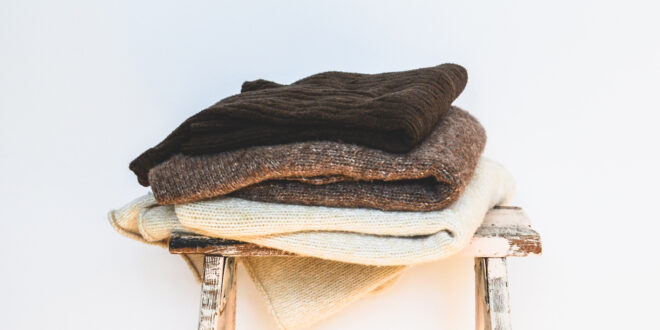There’s nothing like the feel-good comfort of woollen garments as temperatures drop. While these favourites often come with a price tag to match their reputation, they will last for years when you know how to care for them. Care all begins with understanding how wool ‘works,’ because once you have this basic knowledge, you can call on your initiative, as well as your individual garment’s laundering instructions, to get things right. So, read on to find out more about the fibre New Zealand is so famous for producing:
Fabulous fibre
One way only
Wool, whether it’s found on the back of a sheep, or in a ball of yarn, is constructed of individual fibres. Each fibre (or ‘strand’) is coated with overlapping ‘scales,’ with the scales all pointing in one direction. This special feature means the fibres can exist side by side without ever tangling – unless of course we rub them vigorously, in which case they will stick together.
Water repellent
Each wool fibre has a water-repellent coating. That’s why a light shower of rain won’t soak a woollen garment (although exposure to prolonged rain, will). It’s also why staining is less likely to occur in a woollen garment than in a synthetic one – the staining liquid is partially repelled rather than being completely absorbed. Along with being water-repellent, wool fibres have the ability to wick water away from skin, to the outer surface of a garment (or fleece), where it can evaporate. This is because there are pockets amongst the wool fibres which allow air to circulate.
Spring-back
Wool fibres posess a naturally ‘elastic’ quality, thanks to an inner core of cells in each one that operate a little like ‘springs.’ This springiness is what helps woollen garments keep their shape, and prevents them from wrinkling.
Putting it all together
It’s so important to read the laundering instructions on any item of clothing or ball of yarn, so in the first instance, always consult the professional advice before you begin the cleaning process. But now, as you do so, you’ll be able to understand the reasons for the do’s and don’ts.
When the advice is not to rub, agitate, or machine wash a woollen garment, it’s because these actions may result in the wool fibres sticking together, and cause your item to become felted and lumpy. Felting also closes the gaps in the structure of the wool, which means air can’t circulate as freely. This means your garment won’t have the same wicking qualities, and it will be more difficult for it (and you) to dry out.
When the advice is to avoid harsh detergents and fabric softeners, it’s because products such as these can destroy the springiness in the central core of woollen fibres, causing your garment to become limp and non-elastic. The same damage can be wrought by using an iron on a woollen garment (or, where pressing is permitted, an iron set to too high a temperature).
While some woollen garments and yarns, such as some (but not all) in the merino range, have been specially constructed for easy-care machine laundering, other woollen garments need to be handled with kid-gloves. Treat them to gentle handwashing in luke-warm water, and laundry soaps designed specially for the purpose. Squeeze-dry (never ‘wring’), and absorb extra moisture by rolling the garment in a towel. Lay flat, on a clean towel, and dry out of direct sunlight, never hanging the garment, as it will stretch out of shape. Fold and store loosely in a drawer or container. Unless the garment is marked as moth-proof, always store in a sealed situation.
Winter-proof yourself with wool – and give this amazing fibre the care it deserves.








Join the Discussion
Type out your comment here:
You must be logged in to post a comment.